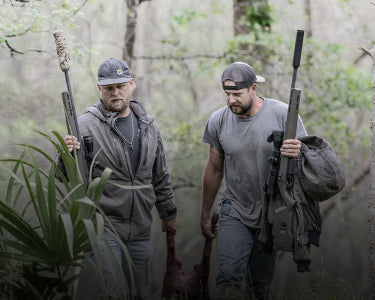Whitetail Deer Hunting
Whitetail deer are the most hunted prey animal in the United States. Deer season is determined by each state but generally occurs between November and January.
Every year, tens of thousands of hunters—bow and rifle—venture into America’s forests to harvest venison (deer meat). Not only is venison delicious but reducing the deer population is vital for environmental health.
Deer can spread diseases, which are dangerous to both humans and livestock. Deer-vehicle collisions kill about 200 people annually and cost the automotive industry roughly $1 billion. Deer eat over 700 species of commercials crops, costing farmers millions each year.
For these reasons, it is essential responsible gun owners do their part in the upcoming deer season! Venison is delicious, buck antlers look great on the wall, and hunting is an extremely healthy outdoors activity.
Now, let’s look at 4 simple tips to help you maximize your chances of harvesting (many) deer this season!

Pro-Tip #1
Have Your Rifle Sighted-In
Wouldn’t it be hilarious to follow every tip on this list, but when you get to the ‘moment of truth’, your shot completely misses the deer? Exactly—it would not be funny at all.
This is perhaps the simplest rule…check your rifle’s precision beforehand. Go to the range or a rural area that’s safe (and legal) for shooting, and ensure that your rifle is firing true.
You want to be aware of the distance you’re shooting, the bullet drop, gravity, muzzle velocity, temperature and wind. The best way to quickly sight-in without wasting money on extra ammunition is to use an in-chamber boresight.
Go to www.sightmark.com and check out some affordable boresights! These precious little sights are worth every penny!

Pro-Tip #2
Scout/Know the Area First
Wherever you hunt, you must know and comply with local laws. Bag limits, types of permissible devices (night vision and thermal are not universally legal) and property boundaries are not lightly-made recommendations—they are law.
Before you hunt anywhere, check with the game warden and local authorities to ensure you are hunting legally.
Once you’re cleared to legally hunt, scout the area. This means go during the bright daylight hours, when you’re not actively hunting, and learn the game trails.
Where do the animals come from? Where do they hide their young? Where do they drink and feed? Are there any hazards in the area, like unexpected cliffs, poisonous plants, barbed wire or unstable ground?
Before you hunt, take some time to look around the area and familiarize yourself with the surroundings. When you venture out to hunt in low-light conditions, you’ll be thankful that you invested the time to learn the landscape.

Pro-Tip #3
Be Invisible and Punctual
This is when you reveal your inner ninja. Deer are generally elusive and skittish, so you need to be aware of your scent and noises. You should take a shower or bath before hunting, and then treat your clothes with a scent killer because deer can smell nearly 50 times better than humans!
If possible, you also want to stay downwind of your quarry. Wear camouflage, if you own it, to increase your ninja-ness, because deer can also see up to 50 times better at night than a human!
You should depart for your tree-stand or deer blind about ½ hour before the sun sets (or rises) so you have time to settle in before the deer populations become active.
Deer are generally crepuscular, which means they are most active at dawn or dusk—this is prime hunting time.

Pro-Tip #4
Take an Ethical Shot
Take a smart, ethical shot. You don’t want to gut-shot a deer—it will run for miles in agony before collapsing, and suffering, until death. This is cruel and inhumane.
You also don’t want to ‘graze’ a deer and simply blow off an antler, or a tail, and leave the animal wounded, disfigured, and worst of all, still alive.
You also don’t want to shoot a family pet or livestock. This means you need positive target identification before firing.
And finally, a smart, ethical shot will result in the best-tasting venison possible—and this is not conjecture. An animal that dies slowly releases a nasty concoction of hormones that render their meat tough and tasteless.
Animals that are stressed or scared just before death taste awful. The makers of Kobe beef know this well. They reportedly give their cows alcohol (Sake), they massage the cows and sing classic Beatles songs to them (probably).
This unique approach of animal-focused comfort—before slaughter—results in fantastic marbling of the beef, whereas the strands of fat are instantly melted during preparation, resulting in some of the most succulent beef in the world.
This biological truth holds for venison as well—take a smart, ethical shot for the best tasting meat possible.

Deer Hunting Concluded
Deer season is the best time of the year. The weather is cooling down, the holidays are approaching, and the time for harvest has finally arrived.
Competent, responsible hunting is one of the most enjoyable, social and healthy activities that you can engage in.
Simply follow the above tips: Have your rifle sighted-in, scout/know the area first, be invisible and punctual and take an ethical shot.
Happy hunting!




